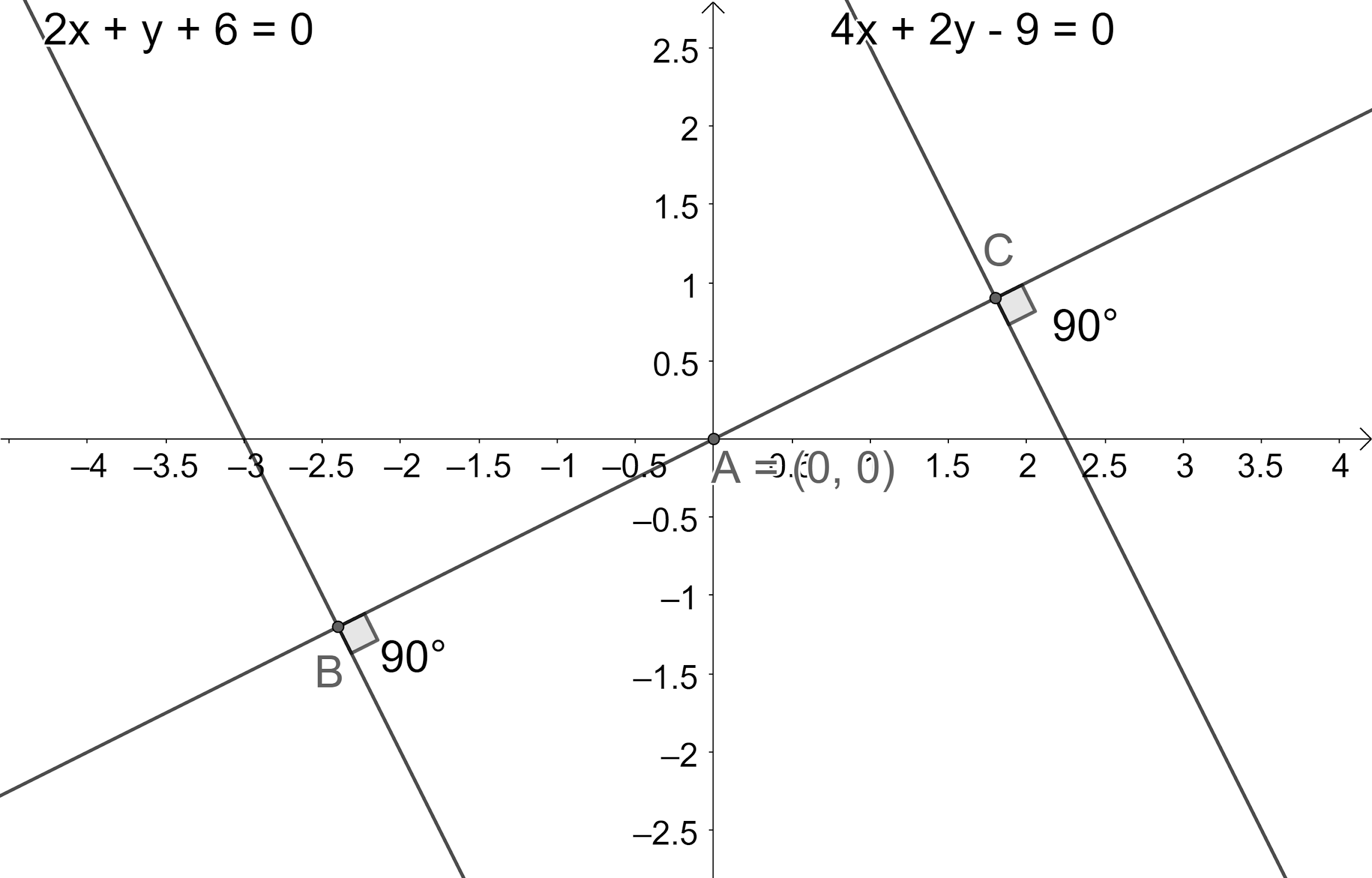
A-line passing through origin and is perpendicular to two given lines $ 2x+y+6=0 $ and $ 4x+2y-9=0 $ . The ratio in which the origin divides the line, is
(a) 1:2
(b) 2:1
(c) 4:2
(d) 4:3
Answer
550.2k+ views
Hint: We start solving the problem by drawing the figure representing the given information. We then recall the fact that the perpendicular distance from the point $ \left( {{x}_{1}},{{y}_{1}} \right) $ to the line $ ax+by+c=0 $ is $ \dfrac{\left| a{{x}_{1}}+b{{y}_{1}}+c \right|}{\sqrt{{{a}^{2}}+{{b}^{2}}}} $ to find the perpendicular distance from origin to the lines $ 2x+y+6=0 $ and $ 4x+2y-9=0 $ . We then ratio of the obtained distances to get the required answer.
Complete step by step answer:
According to the problem, we are given that a line passing through the origin and is perpendicular to two given lines $ 2x+y+6=0 $ and $ 4x+2y-9=0 $. We need to find the ratio in which the origin divides the line.
Let us draw the figure representing the given information.

From the figure, we can see that we need to find the ratio of AB to AC.
We can see that AB and AC are the perpendicular distances from the point $ A\left( 0,0 \right) $ to the lines $ 2x+y+6=0 $ and $ 4x+2y-9=0 $ .
We know that the perpendicular distance from the point $ \left( {{x}_{1}},{{y}_{1}} \right) $ to the line $ ax+by+c=0 $ is $ \dfrac{\left| a{{x}_{1}}+b{{y}_{1}}+c \right|}{\sqrt{{{a}^{2}}+{{b}^{2}}}} $ .
Now, we get $ AB=\dfrac{\left| 2\left( 0 \right)+\left( 0 \right)+6 \right|}{\sqrt{{{2}^{2}}+{{1}^{2}}}} $ .
$ \Rightarrow AB=\dfrac{\left| 6 \right|}{\sqrt{4+1}} $ .
$ \Rightarrow AB=\dfrac{6}{\sqrt{5}} $ ---(1).
Now, we get $ AC=\dfrac{\left| 4\left( 0 \right)+2\left( 0 \right)-9 \right|}{\sqrt{{{4}^{2}}+{{2}^{2}}}} $ .
$ \Rightarrow AC=\dfrac{\left| -9 \right|}{\sqrt{16+4}} $ .
$ \Rightarrow AC=\dfrac{9}{\sqrt{20}} $ .
$ \Rightarrow AC=\dfrac{9}{2\sqrt{5}} $ ---(2).
Now, let us take the ratio of AB to AC using the obtained values from equations (1) and (2).
So, we have $ \dfrac{AB}{AC}=\dfrac{\dfrac{6}{\sqrt{5}}}{\dfrac{9}{2\sqrt{5}}} $ .
$ \Rightarrow \dfrac{AB}{AC}=\dfrac{6\times 2}{9} $ .
$ \Rightarrow \dfrac{AB}{AC}=\dfrac{4}{3} $ .
So, we have found the ratio that origin divides the line as 4:3.
$ \therefore, $ The correct option for the given problem is (d).
Note:
We should perform each step carefully in order to avoid confusion and calculation mistakes. We can also solve this problem by finding the equation of the line passing through the origin and then finding the intersection points and then finding the distance between those points and the origin. Similarly, we can expect problems to find the perpendicular distance between the given parallel lines.
Complete step by step answer:
According to the problem, we are given that a line passing through the origin and is perpendicular to two given lines $ 2x+y+6=0 $ and $ 4x+2y-9=0 $. We need to find the ratio in which the origin divides the line.
Let us draw the figure representing the given information.

From the figure, we can see that we need to find the ratio of AB to AC.
We can see that AB and AC are the perpendicular distances from the point $ A\left( 0,0 \right) $ to the lines $ 2x+y+6=0 $ and $ 4x+2y-9=0 $ .
We know that the perpendicular distance from the point $ \left( {{x}_{1}},{{y}_{1}} \right) $ to the line $ ax+by+c=0 $ is $ \dfrac{\left| a{{x}_{1}}+b{{y}_{1}}+c \right|}{\sqrt{{{a}^{2}}+{{b}^{2}}}} $ .
Now, we get $ AB=\dfrac{\left| 2\left( 0 \right)+\left( 0 \right)+6 \right|}{\sqrt{{{2}^{2}}+{{1}^{2}}}} $ .
$ \Rightarrow AB=\dfrac{\left| 6 \right|}{\sqrt{4+1}} $ .
$ \Rightarrow AB=\dfrac{6}{\sqrt{5}} $ ---(1).
Now, we get $ AC=\dfrac{\left| 4\left( 0 \right)+2\left( 0 \right)-9 \right|}{\sqrt{{{4}^{2}}+{{2}^{2}}}} $ .
$ \Rightarrow AC=\dfrac{\left| -9 \right|}{\sqrt{16+4}} $ .
$ \Rightarrow AC=\dfrac{9}{\sqrt{20}} $ .
$ \Rightarrow AC=\dfrac{9}{2\sqrt{5}} $ ---(2).
Now, let us take the ratio of AB to AC using the obtained values from equations (1) and (2).
So, we have $ \dfrac{AB}{AC}=\dfrac{\dfrac{6}{\sqrt{5}}}{\dfrac{9}{2\sqrt{5}}} $ .
$ \Rightarrow \dfrac{AB}{AC}=\dfrac{6\times 2}{9} $ .
$ \Rightarrow \dfrac{AB}{AC}=\dfrac{4}{3} $ .
So, we have found the ratio that origin divides the line as 4:3.
$ \therefore, $ The correct option for the given problem is (d).
Note:
We should perform each step carefully in order to avoid confusion and calculation mistakes. We can also solve this problem by finding the equation of the line passing through the origin and then finding the intersection points and then finding the distance between those points and the origin. Similarly, we can expect problems to find the perpendicular distance between the given parallel lines.
Recently Updated Pages
Master Class 12 Business Studies: Engaging Questions & Answers for Success

Master Class 12 Economics: Engaging Questions & Answers for Success

Master Class 12 English: Engaging Questions & Answers for Success

Master Class 12 Maths: Engaging Questions & Answers for Success

Master Class 12 Social Science: Engaging Questions & Answers for Success

Master Class 12 Chemistry: Engaging Questions & Answers for Success

Trending doubts
Who was the first woman to receive Bharat Ratna?

Write a letter to the principal requesting him to grant class 10 english CBSE

Why is there a time difference of about 5 hours between class 10 social science CBSE

What is the median of the first 10 natural numbers class 10 maths CBSE

The Equation xxx + 2 is Satisfied when x is Equal to Class 10 Maths

Discuss the main reasons for poverty in India




